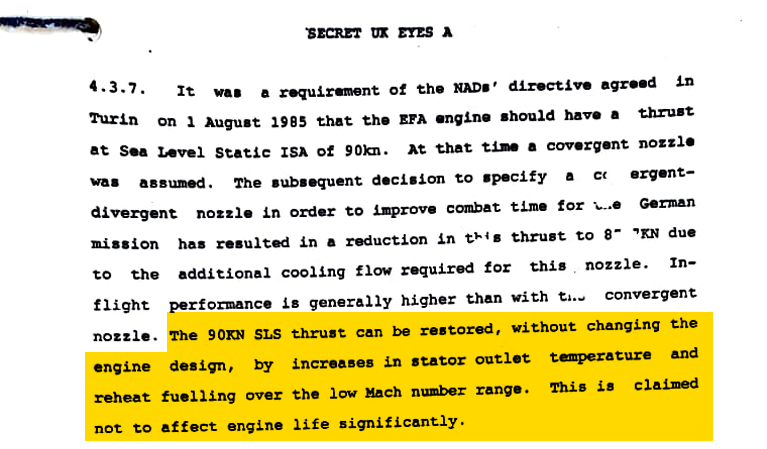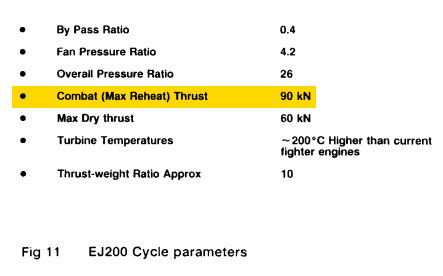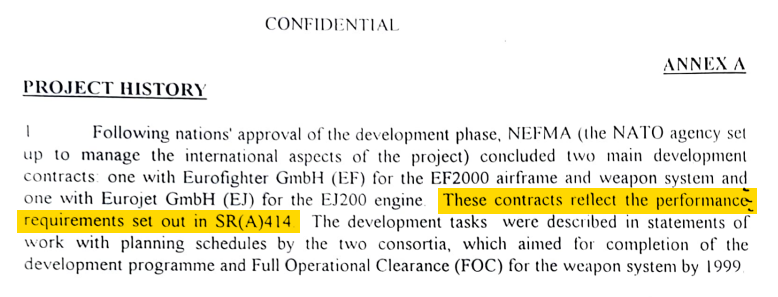It’s in the Indian flight manuals I believe?
Our only hope is Turkey load up their Typhoons in murder mode when they get them…
It’s in the Indian flight manuals I believe?
Our only hope is Turkey load up their Typhoons in murder mode when they get them…
In french service those are f4.1 with 8 missiles but like i explained f3r was able to do so and that did convinced the devs.
And well why do you ask such things especially if you know that you won’t see what you are asking for eurofighter for example, try your luck and bug report the eurofighter with the pilot saying such things, it won’t go far.
literally search up indian f3r, french f3rs do not have 8 mica missiles, but the export indian ones do. that’s different to eurofighter, in which none of the operators have a loadout of more than 6 arh missiles at least that was publicly showcased mounted on a eurobomber
You’ve also got Brochures from the Eurofighter Consortium showing that configuration, but unfortunately the devs dont consider the Manufacturer a usable source for bug reporting the Typhoon
If i understand well the brochure literally get contradicted by one of the message above about the max amram loadout sooooo
that document never stated where those amramms are mounted tho
The doc above is from 1994. 9 years before it entered service and does specify “AWX role” so it may simply be referring to a specific mission role/loadout.
So…
It simply states that the loadouts the RAF had planned for the aircraft. Doesnt state anywhere that the inner pylon cannot, under any circumstance, be fitted with AMRAAM or even Meteor that didnt enter service for another 20 years. Things may have changed in the intervening years. Though, if you want, Im sure we can bug report the Rafale F3 not having HMD when it was still in a prototype phase or even in operational service
But the devs want the Typhoon artificially nerfed, so doesnt stand much chance actually getting that loadout. Still not even allowed its historically accurate radar, HMD, Cockpit/HUD, Flight model, A2G loadout, A2A loadout, etc etc. Not even allowed historically accurate CMs
That too.
Isnt it 10 thought i read about that some where
I’ve finally had time to type up a reply.
Ok, I see where the disconnect has arisen now, didn’t realise you were arguing about the static thrust not being 90 kN (it didn’t help that you pulled 86.3 kN from somewhere, but in hindsight that was obviously a typo). The research I’ve done on the matter (reading thousands of pages worth of documents at different archives) has led me to conclude that a static thrust of 90 kN was the most likely value, so that’s what I went with.
The requirement for the EJ200 to produce 90 kN of static thrust was written into the European Staff Requirement, which was signed by the partner nations in 1985, formally starting the programme. EuroJet worked on designing the EJ200 to meet the requirements under the assumption that a convergent nozzle would be used. During the development of the Eurofighter it became apparent that the German requirement for rapid acceleration performance at Mach 1.8+ could not be achieved without the use of convergent-divergent nozzle. EuroJet were therefore forced to change the design of the engine to use the new nozzle type. Their initial estimate was that static thrust would be reduced to 87.3 kN; however they also stated at the time that they believed the full 90 kN static thrust rating could be restored, by adjusting the engine stator temperature and reheat fuelling schedule (with only an insignificant impact on engine life). MOD(PE) chose to use 87.3 kN in their modelling to represent the worst case performance if the static thrust could not be restored.

In all the material I have read I’ve not found any mention of mention of the 90 kN thrust requirement ever being changed since 1985 (by comparison I’ve seen plenty of other requirement changes discussed); therefore with the information available I can only conclude that 90 kN requirement specified for the engine was retained throughout the programme. While I have not found anything to suggest the engine specification was changed I have found stuff to suggest it was met, such as this statement from 1994.

In addition to that literally every single primary & secondary source I’ve seen, so far, from the last 30 years has listed the static uninstalled thrust of EJ200 as 90 kN. The vast majority of the evidence supports a static thrust rating of 90 kN so that is what I went with. In summary:
That graph is not exactly a smoking gun. The purpose of the graph is to demonstrate the performance difference between a convergent nozzle and a convergent-divergent nozzle; that comparison only makes sense to do if you are going to have all other aspects of the engine be considered equal. I expect a convergent-divergent nozzle would produce a little less thrust than a convergent nozzle, all other things being equal; however it is entirely possible that the static thrust shortfall was made up for by increasing stator temperature as EuroJet originally proposed. The graph also specifies 1% thrust loss in a region of the flight envelope, not specifically under static conditions, so it is possible (in fact even likely) that the thrust loss is not uniform across that area of the flight envelope. It may even be the case that the static thrust was 90 kN, but at other speeds / altitudes it drops off more compared to a convergent nozzle. I would note that the image next to the one you shared states the thrust is 90 kN.

Let’s look at the timeline:
Now in my mind the logical conclusion based on the above series of events is:
If you disagree then answer me then I would be curious to hear your answer to this question:
In 1987 the MOD predicted that the Eurofighter would fail to meet 9/10 of the STR and ITR requirements (which they considered to be pretty important as far as flight performance requirements go), yet in throughout the 1990s internal documents from the same MOD say stuff like “there is a high degree of confidence that EF2000 will meet its aerodynamic performance requirements”, “the engines are expected to meet their performance and mass targets”, and “The performance of the engine on the bench already meets its full specifications for thrust”. If the finished Eurofighter was still performing in accordance with the 1987 estimates how do you explain the sudden change of tone from the MOD?
Wait are you saying that they wrote a 200 page requirements document only for most of it to never be used? I guess I have the benefit of having read through hundreds of Eurofighter documents over the last couple of years, and knowing that barely a document goes by without the ESR-D being mentioned. But even without that knowledge that’s a pretty wild take. Four nations don’t spend months / years negotiating a comprehensive set of requirements among themselves and then just tell the contractor to ignore the requirements and build whatever the hell they want. That’s not how engineering works.
But I will humour you and also address this one while we’re at it:
The two Eurofighter contracts “reflect the performance requirements set out in SR(A)414”

What’s SR(A)414 I hear you ask? It stands for “Staff Requirement (Air) 414”. When the armed forces want something it gets assigned a requirement number by the MOD. Air Requirement 414 is the one issued for Eurofighter, and it just so happens to be… the ESR-D.

I can keep producing documents showing that the ESR-D (and its earlier forms) was the central document which the Eurofighter programme was built around, not something written and forgotten about, but of all the things we could debate this really isn’t one that’s worth the effort.
I’m not blindly assuming the ESR-D was met in full (there are parts that were not), but where there is convincing evidence that parts of it were I will argue that the those numbers in the ESR-D are better guidelines for performance than estimates made in 1987 about a demonstrably different aircraft.
Also I think most people would agree that the engines are essentially smokeless for the vast majority of that display. The fact that there is some smoke visible for a few seconds (on a number of occasions you can count on one hand), out of a 15 minute air display really isn’t the gotcha you think it is.
As @Fireball_2020 said the original intention of the requirement was that you shouldn’t get a bunch of visible smoke come out of the engine when switching to afterburner; which was a problem on some earlier aircraft. It is obvious that afterburners produce flames, which in turn produce light, which in turn makes them visible from a distance at night. The change was just an update to the wording of the requirement to clarify the original intention; it was not a change to the requirement.

In fact don’t you think that something so minor needing to be amended in the ESR-D, instead of simply ignored, kinda flies in the face of your notion that the ESR-D was largely ignored?
Thanks, it was a pretty long and busy Monday (the same could be said for the rest of the week as well), but I appreciate the sentiment. I hope you’ve had a wonderful week.
What were the German requirement for M1.8+ acceleration? Cuz atm, the in-game EFT acceleration at high speeds is pretty middling. Nothing someone would consider “rapid” compared to period appropriate competitors as modelled in WT id think…
There is evidence of a Rafale carrying 8 missiles though. Same can’t be said about the Eurofighter situation where there is no evidence for more than 6 AMRAAMs ever actually being carried.
Not that I’m a massive fan of the way Gaijin’s handled the Rafale situation.
(Community Bug Reporting System)
This is a bit of a joke, how is this not enough information that it’s clearly broken?
Why close the thread instead of just asking for more info? So frustrating…
Guess it needs to be re-uploaded with a game replay or something?
Did you Include the Replays and Gamelogs? They need those
Not my report, might be able to do some today but unlikely, on my way to RIAT later
I can’t see the replay anymore and right now I can’t get it back. The report does have the gameplay recorded in real time though, with screenshots of the exact moment and comparisons with other planes. But it seems like that’s still not enough. When I get some time, I’ll play another match and make another report, since this happens almost every game.
That said, I’m starting to feel like if they don’t actually want to fix it, it doesn’t matter how many reports you send. They either get ignored, end up in “forwarded for review” where they’ll just sit with thousands of others, or you get some generic reply just to avoid acknowledging the issue. It’s getting a bit frustrating.
Yeah, will need the gamelog file for a report like this unfortunately.
I’m keeping an eye out for a good clear instance where it occured to report it again, but I dont tend to use the HMD/ACM as part of my default

